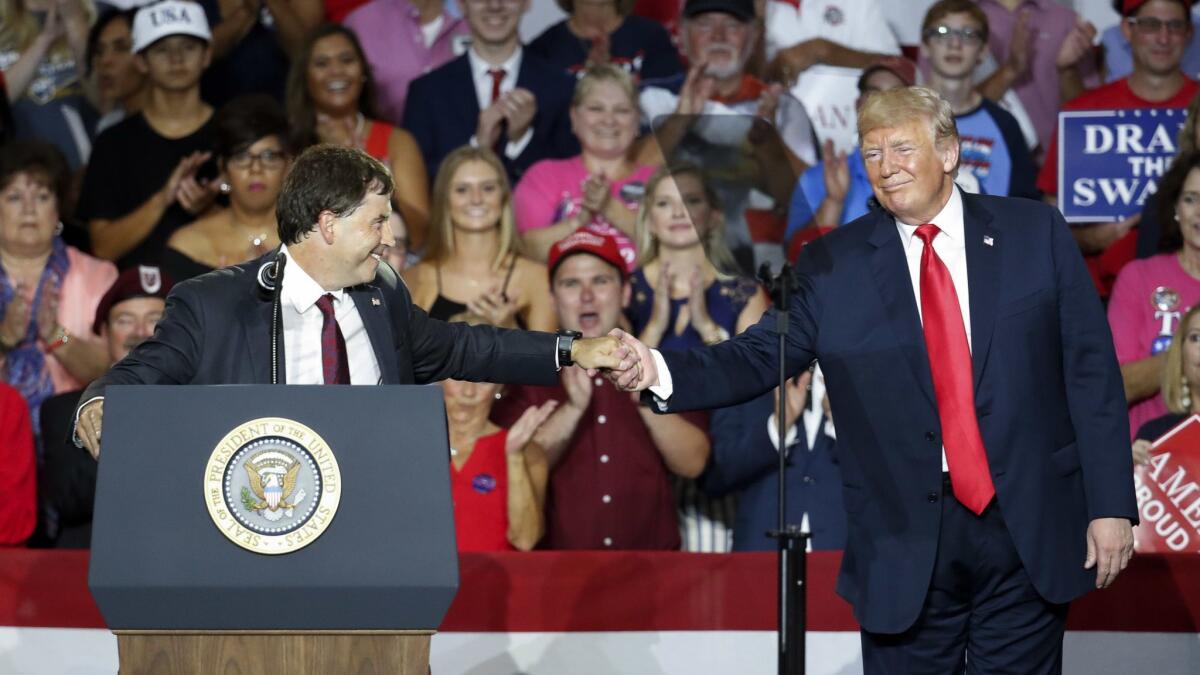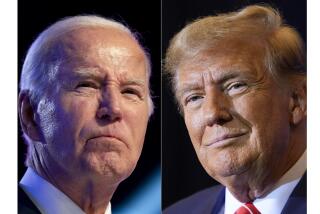Ohio voters head to the polls in a toss-up contest, a last dress rehearsal for the midterm election

Two types of voters have gotten out-sized scrutiny in the run-up to this year’s midterm election — blue-collar whites who moved to Donald Trump in 2016 and college-educated suburbanites who have shunned the president ever since.
Ohio’s 12th Congressional District has big batches of both, which is one reason Tuesday’s special election there has commanded attention from strategists in both parties, even though the winner will fill the seat for only a few months.
Another reason: Democrats, once again, have a decent chance of winning an election in a district that was considered safely Republican. If Danny O’Connor, the Democratic candidate, does prevail, the gloom already settling around congressional Republicans will deepen measurably.
Even if the Republican, Troy Balderson, pulls out a victory, the GOP celebration may be muted as the district, in the central part of the state, tilts so heavily their way that the race never should have been close.
The Ohio special election tops the bill, but several other states vote Tuesday as well, with primaries that will provide clues about each party’s path. In both Michigan and Kansas, voters will choose nominees for governor in races that pit establishment-backed candidates against those with more fervent ideologies — liberal Democrats and Trump-style Republicans.
Get the latest news from the nation’s capital on Essential Washington >> »
In Michigan, Gretchen Whitmer, a former state legislator with backing from labor unions and women’s groups, has an unquestionably liberal record. But hers wasn’t the hand that Sen. Bernie Sanders clasped on Sunday at a campaign rally in Detroit. Instead, the Vermont independent touted the progressive credentials of Abdul El-Sayed, the 33-year-old former chief of the city’s health department, who has run determinedly to Whitmer’s left.
The contest marks the latest to feature a candidate from the party’s Sanders wing against a more conventional Democrat. So far, the further left candidates have mostly lost, but they did win a major upset in June when Alexandria Ocasio-Cortez won a congressional primary in New York City, defeating a member of the Democratic congressional leadership.
Whitmer has touted her work to expand Medicaid under the Affordable Care Act, a move that has provided coverage for some 600,000 state residents, government figures show. But she has opposed calls for a statewide single-payer plan pushed by El-Sayed, saying she won’t endorse “buzz phrases” that would require major tax increases.
A third candidate, Shri Thanedar, has complicated the race. The novice politician but successful entrepreneur has dumped millions of his own money into the campaign. He also favors a single-payer health plan.
If elected, El-Sayed would be the nation’s first Muslim governor, a status that has added to the attraction for some in the anti-Trump resistance.
The opposite case has roiled the Republican campaign in Kansas, where the race pits the establishment against a candidate from the right, and tests Trump’s appeal among his supporters.
Incumbent Gov. Jeff Colyer took over in January when his predecessor, Sam Brownback, stepped down to take an ambassador’s post. Colyer wants a full term of his own. But he’s being challenged by Kris Kobach, a favorite of Trump’s who has promised to run an even more conservative administration than Brownback’s.
Against the wishes of the Republican Governor’s Assn., which mostly exists to back incumbents, and some White House staff members, President Trump jumped into the race on Monday with a tweet endorsing Kobach, whom he labeled “a strong and early supporter of mine.”
Some Republican operatives fear that Kobach, who became well known for crusading against illegal immigrants and has persistently pushed debunked claims of widespread voter fraud, will turn off moderately conservative voters. That could not only risk handing the governor’s race to a Democrat, but also endanger two Republican congressional seats in the state.
Former Sen. Bob Dole of Kansas responded to Trump with a tweet endorsing Colyer, calling him “our best choice to win tomorrow AND in the fall.” Trump, however, has a record of swaying Republican primaries with his tweets this year, so Kobach may now be the favorite in the race.
The president has had little success, however, in general elections. In March, for example, he flew to Pennsylvania to campaign for Rick Saccone, the Republican in another closely watched special congressional election. Saccone went on to lose to Conor Lamb, a Democrat.
This weekend, Trump flew to Ohio to campaign for Balderson. His presence could help in the more rural parts of the district, where Trump in 2016 did better than Republicans typically do. Balderson will need a strong turnout of white, blue-collar Trump supporters.
But whatever gains Balderson gets from those voters could be offset by losses in the more populated part of the district, the suburbs of Columbus, the state capital. Many Republican voters in that part of the district dislike Trump.
That would include the state’s Republican governor, John Kasich, who used to represent the area in Congress and who has consistently feuded with Trump.
In an interview Sunday on ABC’s “This Week,” Kasich said Balderson had told him that he didn’t invite Trump to campaign for him.
Trump’s appearance could hurt Balderson because “the chaos that seems to surround Donald Trump has unnerved a lot of people,” Kasich said.
“Suburban women in particular here are the ones that are really turned off,” he added. The fact that the race remains close is “really kind of shocking because this should be just a slam dunk, and it’s not,” he said.
For more on Politics and Policy, follow me @DavidLauter
More to Read
Get the L.A. Times Politics newsletter
Deeply reported insights into legislation, politics and policy from Sacramento, Washington and beyond. In your inbox three times per week.
You may occasionally receive promotional content from the Los Angeles Times.







